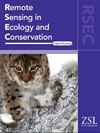Assessing group size and the demographic composition of a canopy‐dwelling primate, the northern muriqui (Brachyteles hypoxanthus), using arboreal camera trapping and genetic tagging
IF 4.3
2区 环境科学与生态学
Q1 ECOLOGY
引用次数: 0
Abstract
Obtaining accurate population measures of endangered species is critical for effective conservation and management actions and to evaluate their success over time. However, determining the population size and demographic composition of most canopy forest‐dwelling species has proven to be challenging. Here, we apply two non‐invasive biomonitoring methods, arboreal camera trap and genetic tagging of fecal samples, to estimate the population size of a critically endangered primate, the northern muriqui (利用树栖相机诱捕和遗传标记技术,对栖息在树冠上的灵长类动物——北毛猴(Brachyteles hypoxanthus)的种群规模和人口组成进行了评估
获得准确的濒危物种数量对于有效的保护和管理行动以及评估其成功与否至关重要。然而,确定大多数冠层森林栖息物种的种群规模和人口组成已被证明是具有挑战性的。本文采用两种非侵入性生物监测方法,即树栖相机陷阱和粪便样本的遗传标记,对巴西Caparaó国家公园一种极度濒危的灵长类动物——北毛猴(Brachyteles hypoxanthus)的种群规模进行了估计。当比较相机捕获和遗传标记的群体规模时,遗传标记调查估计其中一个穆里奇群体的个体数量较少,但另一个群体的群体规模估计略高。就两种方法的成本效益而言,树栖相机捕获的初始成本较高,但从长远来看更具成本效益。另一方面,基因标记不需要昂贵的数据收集设备,但实验室消耗品和数据处理的相关费用较高。我们建议使用这两种方法监测北方muriqui,并提出建议,以改进这些非侵入性方法的实施,以用于未来的常规监测。我们的研究结果还强调了在热带森林中对其他树栖哺乳动物进行树栖相机捕获和基因标记的潜力。
本文章由计算机程序翻译,如有差异,请以英文原文为准。
求助全文
约1分钟内获得全文
求助全文
来源期刊

Remote Sensing in Ecology and Conservation
Earth and Planetary Sciences-Computers in Earth Sciences
CiteScore
9.80
自引率
5.50%
发文量
69
审稿时长
18 weeks
期刊介绍:
emote Sensing in Ecology and Conservation provides a forum for rapid, peer-reviewed publication of novel, multidisciplinary research at the interface between remote sensing science and ecology and conservation. The journal prioritizes findings that advance the scientific basis of ecology and conservation, promoting the development of remote-sensing based methods relevant to the management of land use and biological systems at all levels, from populations and species to ecosystems and biomes. The journal defines remote sensing in its broadest sense, including data acquisition by hand-held and fixed ground-based sensors, such as camera traps and acoustic recorders, and sensors on airplanes and satellites. The intended journal’s audience includes ecologists, conservation scientists, policy makers, managers of terrestrial and aquatic systems, remote sensing scientists, and students.
Remote Sensing in Ecology and Conservation is a fully open access journal from Wiley and the Zoological Society of London. Remote sensing has enormous potential as to provide information on the state of, and pressures on, biological diversity and ecosystem services, at multiple spatial and temporal scales. This new publication provides a forum for multidisciplinary research in remote sensing science, ecological research and conservation science.
 求助内容:
求助内容: 应助结果提醒方式:
应助结果提醒方式:


